The Day They Closed the Grand Canyon (and We Went In Anyway)
The North Rim of Earth's most glorious canyon burned down and a chemical leak forced evacuations. We were still scheduled to descend to the canyon floor. A multi-part series.
Note: I started writing about our epic experience and found myself chronicling it all in more detail than I expected, particularly the traumatic beginning. For a far more poetic and beautiful (and shorter) reflection on the trip, check out Johanna’s post and the subscribers-only photo gallery.
One hot evening in the middle of July I stepped out the back door of our room at the Maswik Lodge on the south Rim of the Grand Canyon. Flakes of ash coated the patio furniture. A small deer wandered out of a nearby stand of trees, bewildered, and ambled around the building into the parking lot, plucking a few green shoots from the side of the curb. In the background, haze hung over everything, adding a sepia filter to a normally vibrant landscape. Gazing skyward, the scene darkened to a sickening grayscale, making it impossible to discern where failing monsoon clouds ended and billows of smoke from across the canyon began.
A family of tourists paused for a second on the sidewalk to raise their phones , pointing them at the indifferent ungulates for a few quick snaps before returning to frowning at the grim surroundings.
The previous day, while we were still en route to Earth’s most famous demonstration of the power of erosion, a pair of wildfires on the opposite side of the abyss blew up. The smaller of the two, named Dragon Bravo, consumed numerous buildings on the North Rim, including the historic Grand Canyon lodge and a wastewater treatment plant.
The flames were less than ten miles to the north as the raven flies. The entire north side of the park was now closed for the remainder of the season, and access to the Colorado River at the bottom of the canyon from our side was also now closed.
Except for us — my wife, teenage daughter and I and a handful of others in our group. We still had the green light to descend down Bright Angel Trail before first light, continue past the closure signs and proceed all the way to the river to meet the commercial whitewater trip we had booked nearly a year in advance.
I stepped back in the hotel room where my wife stood, frowning. This trip had been planned in celebration of a particular milestone birthday and was a source of much anticipation. I grimaced in return and sighed. Our prospects seemed to be either a trip cancelled, postponed or undertaken as planned but in a thick brown haze.
“Shitty,” I said.
Distracted from Disaster
Focusing on the major inconvenience the situation posed for our long-awaited and relatively expensive trip was a weirdly convenient distraction from the unacknowledged tragedy happening across the canyon. We had visited the North Rim of the Grand Canyon and the historic lodge that was in ashes seven years prior. The far less visited side of the great chasm had preserved a more rugged and rustic charm that had long since been paved over on the south side. Now it was closed indefinitely, seemingly reduced to a state of ruin that felt a bit too much like a microcosm of numerous larger things in the world.
As if the script for our journey had been the product of Cormac Macarthy at his most sadistic towards his oft-doomed characters, the fire a short distance to the north would not be the primary threat to our personal plans and biology. The day prior to our arrival had been filled with the bonus drama of a chlorine leak -- a byproduct of the fire destroying the North Rim’s wastewater treatment plant -- which forced additional evacuations of campers and others below the rim. Chlorine gas is heavier than oxygen and other components of the air we breathe and could theoretically drift down into the canyon, potentially poisoning unsuspecting campers and hikers. Getting poisoned by industrial chemicals in the backcountry of a beloved National Park again has some serious The Road vibes.
The remaining haze-marred daylight began to fade, casting long, distorted alien shadows. I recalled the first time I really noticed a sunset. I was nine years old in Colorado and the western sky above the Front Range of the Rocky Mountains turned a kaleidoscopic array of deep reds and oranges unlike any I had ever seen before in the sky. It was so astonishing I asked every adult I encountered for the next 24 hours if they had seen it. My fourth grade teacher explained in eloquent detail how smoke from terrible wildfires in Yellowstone National Park were the actual cause of the dramatic sunset — something to do with particles of soot scattering light. It was all quite counter-intuitive and a bit mind-blowing at the time -- much more interesting than sad.
It was also the only time I remember hearing about a wildfire during an entire youth spent in the western US in the 1980s and 90s. When I returned after college in the early 2000s, fires had already become a near annual occurrence.
The brown haze, falling ash accumulating on my hat and scratch in my throat in July 2025 would have been more sickening if they weren’t now familiar. There were huge wildfires in interior Alaska that soured Arctic summers, the Hayman fire near Denver, and a handful since we moved to New Mexico 20 years ago. The smell, the haze, the sensation more or less the same each time.
The penetrating smell like a lingering campfire followed me into the hotel room, triggering my normally dormant claustrophobia.
I thought, but did not say out loud to preserve some scintilla of hope and even a cautious hint of celebratory attitude, that it was the latest historic catastrophe adding to a swollen background of sadness. I silently ran through a mental montage of wars, natural disasters, scenes of general decline and disorder from the past decade. The symbolism of the fucking Grand Canyon being the latest treasure to go up in flames — in this case, literally — made it all the harder to acknowledge. It’s just a bit too on the nose, even for this collapse era.
The brown air turned to a sickening gray brume as the day gave up on itself and we ambled across the parking lot and into the main lobby of the Maswik where international visitors could be heard demanding that something – anything – be done to rectify the situation outside. Surely there must be rooms beyond the reach of the smoke, after all?
Prometheus’ Primal Blessing and Curse
Fire itself is beautiful and entrancing. There’s a primal, hypnotic quality deeply connected to our evolution, entwined with combustion as it is, that lends a universal appeal to the crackle of embers and dance of flames within a campfire. Larger infernos, too, invite long stares. How many scenes involving large fires, either from movies or real life, feature a crowd standing around and gawking, often including those that may have just escaped from the blaze. Some tropes are just true.
Yet all the short-term byproducts of fire tend to be ugly, from the smoke and ash to the blackened remains and even the terrible tourists.

However when considered over a longer timespan, fire takes on a cleansing, regenerative role, clearing the way for new growth in the form of a shining grove of aspen trees, bountiful crops or even whole new societies, to use a more controversial example.
Such shoehorned silver linings were nowhere near my consciousness as we strode past the fuming tourists at the front desk and proceeded to our orientation in a corner of the dining room.
The tour company had already sought to reassure us over the phone earlier in the day that a headline-worthy demise by chlorine gas at the bottom of the Grand Canyon would no longer be a risk by the time we reached the Colorado River the following day. This was undeniably good news at the center of a mochi ball made of shit we had no idea we would have to choke down – the detail about the chlorine leak had not been included in the national news reports on the fire we’d heard.
Now, as our trip orientation leader slid a half dozen mapbooks of our route across a cafeteria table alongside a large plastic container for each person in our party that would function as personal pee pot for the trip, we were told that the smoke was also not expected to hamper our experience.
This seemed highly unlikely glancing out the window at the plentiful particulate still hanging in the twilight. But the sunk cost, not only in dollars but also in time and anticipation, to get to this actual precipice, was significant and tilted our attitudes towards a guarded optimism.
We took our personal urinals and maps and stepped back out into the haze, which actually did seem to be lifting. I set an alarm for 4:15 a.m. and laid down, wondering if the nausea I felt was from nerves, smoke, cafeteria meats or a combination of all three.
The next sunrise and sunset we would see would be viewed from below the rim of the Grand Canyon. I wondered how they might compare to those tinted by burnt Yellowstone in my youth. Like many men my age, I also thought about the Roman Empire – specifically about the cliché that had something to do with being a prick as Rome burns. What was it? Fidgeting while Rome burns? Something like that. It doesn’t matter anyway.
To Be Continued.


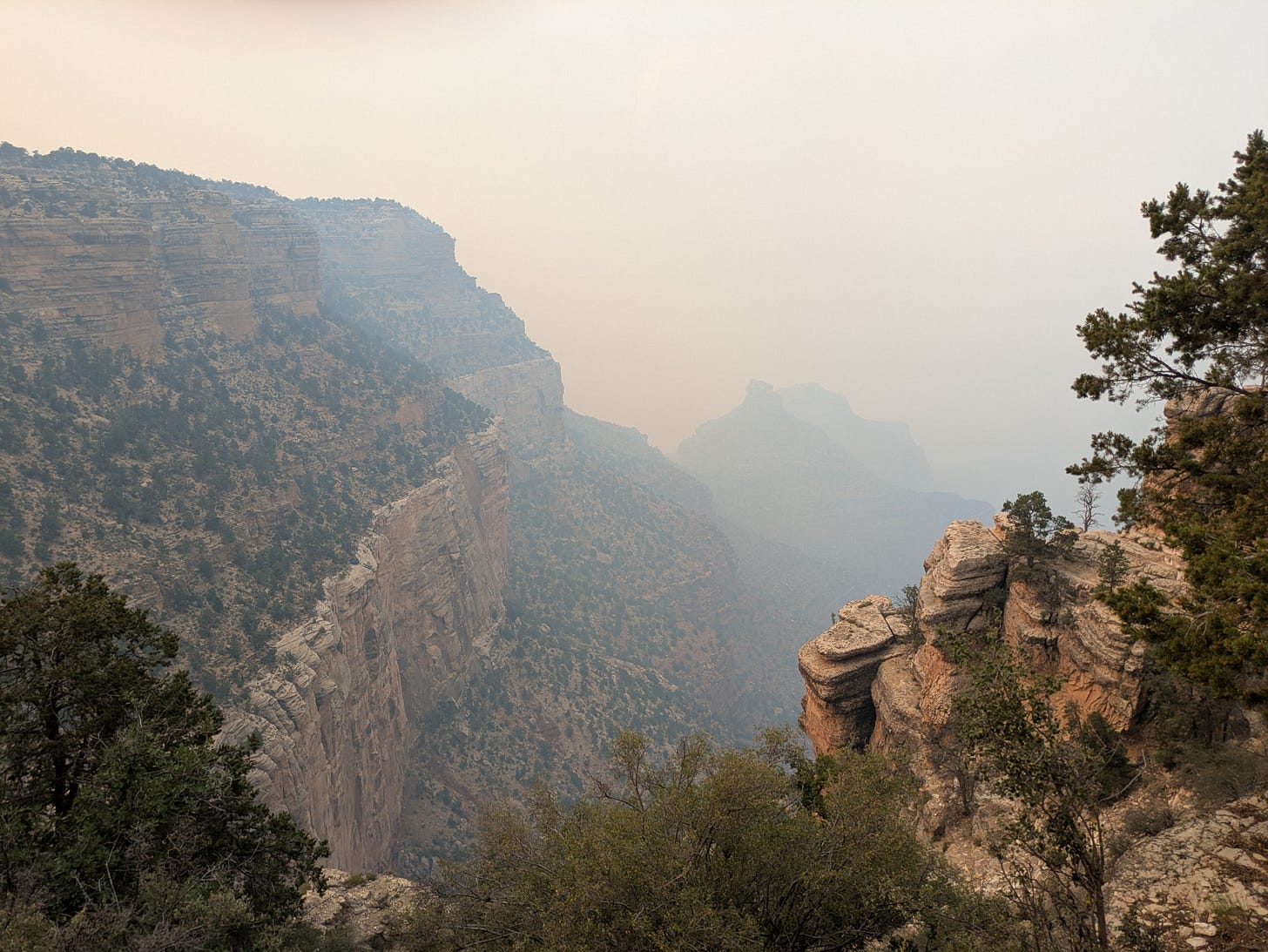
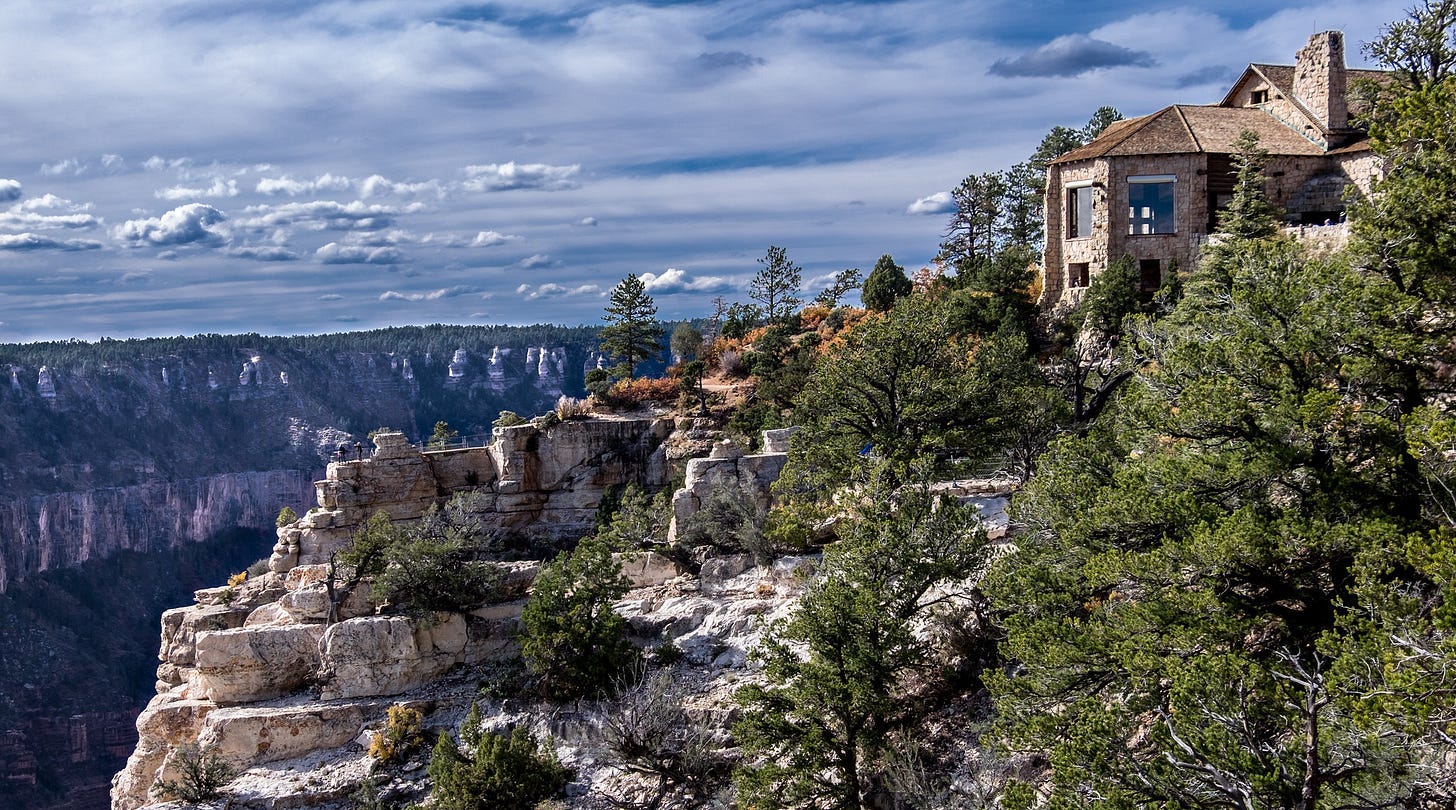
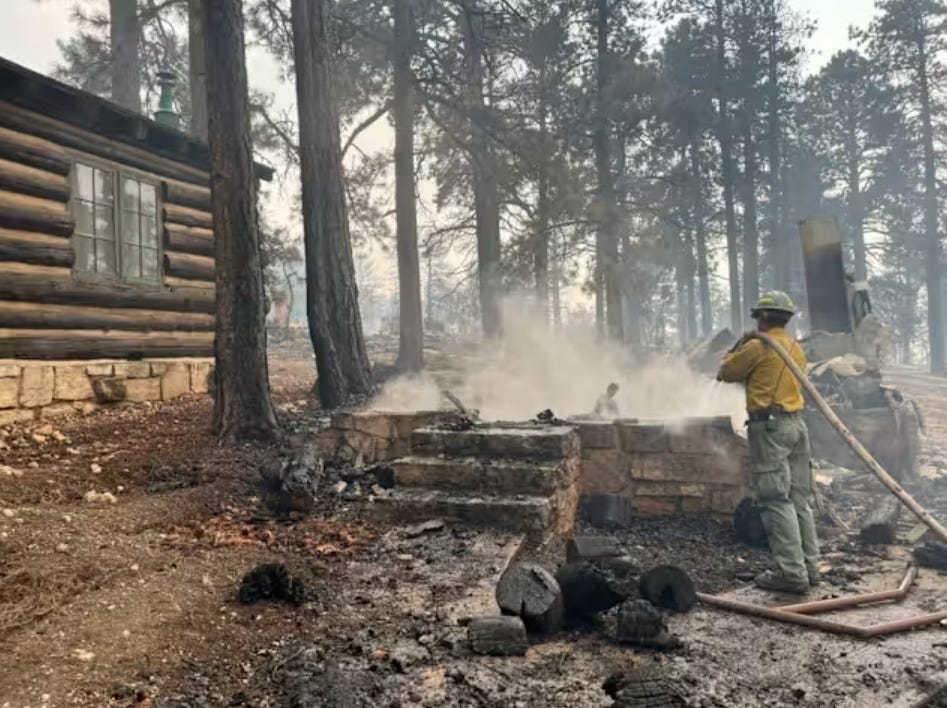
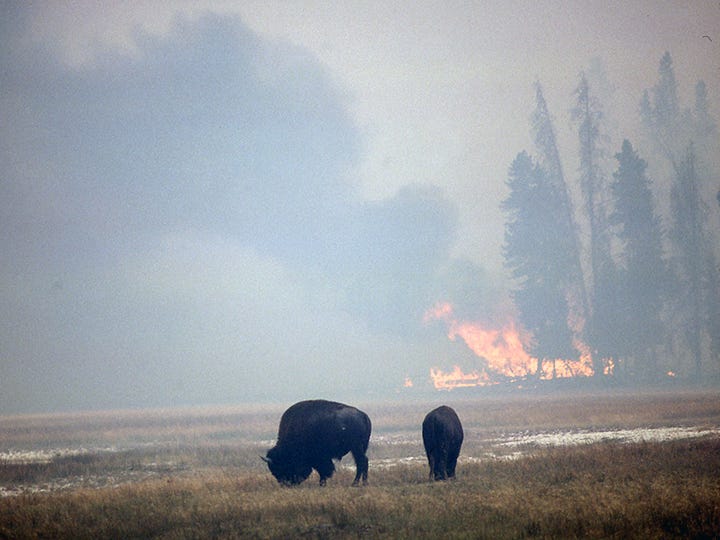
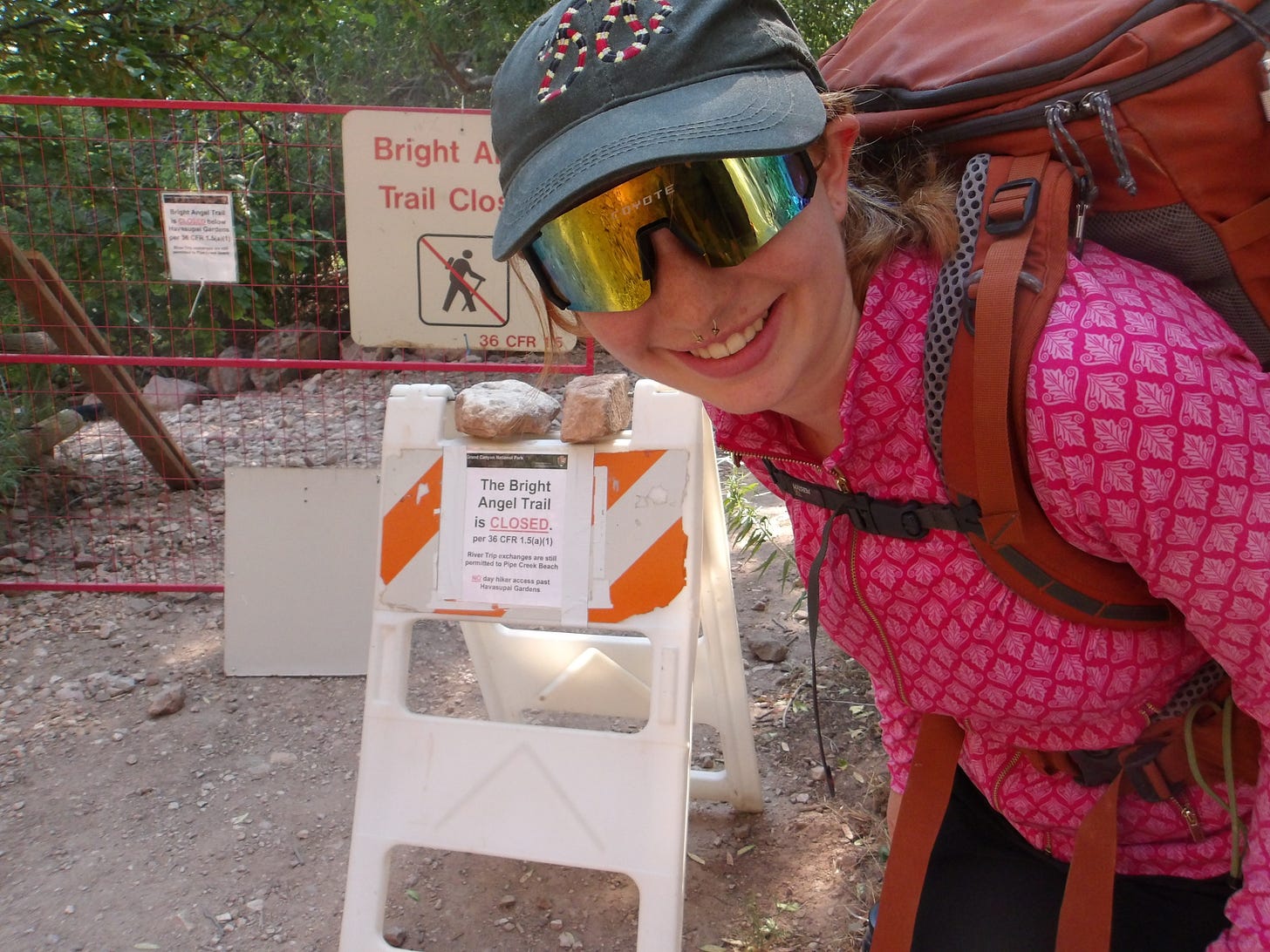
It really is a loss to have the lodge disappear. I appreciate this reflection. 🙏